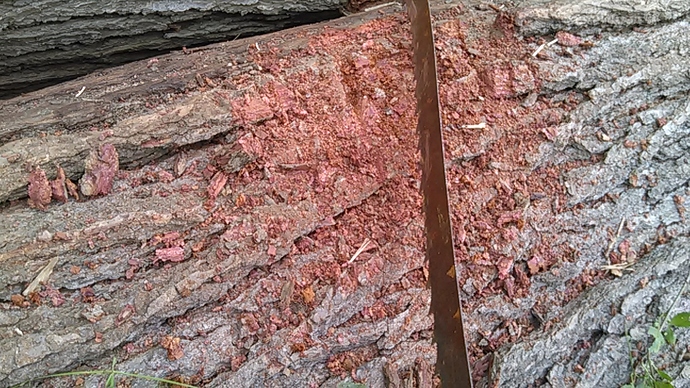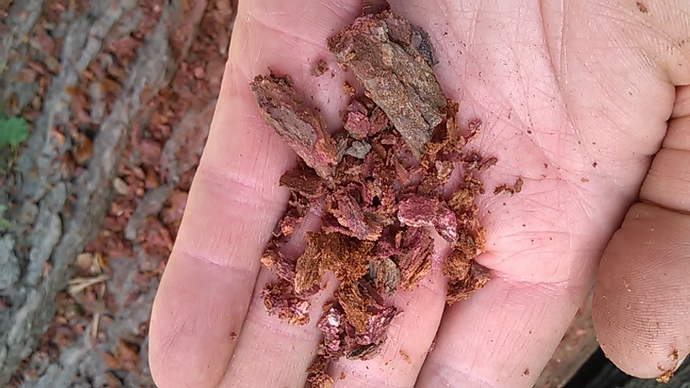I like your thinking. In our business slabs only are more profitable than the milled lumber itself.
Nice operation Jeff. I like to let the pine sit long enough that they de-bark themselves. That way it’s easy and the logs are clean. Just a big mess under the mill though. I suppose that’s hemlock you’re cutting? I don’t recognize it. Does the bark separate by itself?
We milled these two stacks yesterday. 
The sawdust goes in a compost pile to make dirt.
Our Middle-of-July-Alabama-sun showed up so I protected my addled concussed brain with my Mexican sombrero. It sure is good to be able to work again. haha




The limbs and leaves get chipped for :mulch. 
The slabs get cut up for the gasifier or else cut into firewood for greenhouse or house. 



Poplar slabs are stacked in the woods to produce edible mushrooms. 

The bark goes in the chip (mulch) pile for next year’s garden.
When the silos and wood sheds are full the slabs just get burned up. 

Then it rained before we got it stacked so we had to stack it after church today. 


Billy, your setup has me beat ! Nice, those roofs are nice to have. I really need one of those hats, sure been hot out in the sun. I think I need to set up another “big top” just to be in the shade but now a dang electric line might be too close.
Yes, hemlock. Green makes it somewhat easy to spud. But the sun will bake it on like cement. I need to put the pond back on line. I still have about a dozen logs on the bottom. Next time I’ll tie ropes on to the logs. I miss seeing the turtles setting on top of a floating log.
That pile of slabs that get burned could be burned into soil charcoal. For next year the garden will grow up into weeds that get composted along with bark, pond muck and sawdust or what ever I can get my hands on. The homemade soil go into wooden narrow raised bed. The the arched trellis for climbing plants. Maybe something like sweet peas down the middle.
Most of the time, but not always, I leave the branches in the woods.
These ALL work:
with less sweat
with less wastes
with less water
with less 1st world high-tech
with less Idealism
with less endless, never achievable, Perfectionism
The DOing part first is important as it give you a measurable personal matrix to measure changes from.
J-I-C Steve unruh
GaryT, thank you for this tip-off video.
Of course me . . . . I wanted a book version to be able to finger back and fortieth through.
Barns and Noble booksellers had this:
“GARDENING WITH LESS WATER: LowTech, Low Cost Techniques: Use Up To 90% Less Water In your Garden” by David A. Bainbridge
2015 published by Story Publishing ISBN 978-1-61212-582-4
He is primarily American southwest drylands restoration working and living out of dry area San Diego CA.
His primary re-discovery and envelopment is buried porous red glazed fired clay pots as watering reservoirs. Used as single manual fill reservoirs or buried, above ground piping linked “porous capsules”.
Above ground plastic and glazed clay containers with feed-to-the-plant wicks.
He shows buried clay piping sub-watering systems. Not his favored.
His least liked choice - gravity fed ground layed “micro-porous” soaker hoses.
Ground sloping and plantings depression pitting for rain water retention/concentrating.
He has then traveled the world to see how dry-lands peoples are able to grow foods on down to just 5 INCHES annual of rain.
He’d early on tried commercial plastic tubing low pressure point drip-nozzles-emmiters . . . the desert creatures would nibble off the ends! And the emmiter ends would calcium and salts deposits clog! Or he would come back a week or two later and find the solar-panel had quit, the pump died, etc, etc.
Good book.
Climate change and we will all be seasonally needing the-rain-you-got last month solutions.
J-I-C Steve Unruh
Yeah, Jakob is working on his school AT project for the year. Converting that little tractor of his to char. (Thanks for helping him out Don) That project will include a charcoal production system. If we can get that system operating efficiently enough to deal with “higher” volume then we will be able to use up a lot of that waste wood making char. We also have 5-15 barrels of drops (kiln dried dimensional lumber) from the shop/construction crew weekly, so there is no shortage of wood in these parts. I have more dreams on the list for more gasifiers to run the shop etc. But I’ll talk about them when I get to them…everyone has that list …hahaha
Maybe a poh boy could make a debarker out of the old band blades. Cut them at about three feet, say ten of them, hinged. Somehow get the log turning and then move the group of hinged band segments over the log.
Another idea is to use a winch to power a spud down the length of the log.
sounds like a lot of work Jeff, but I imagine it would work. Put blades in a frame about 24" wide. bldes 3’ long on a hinge that can just lay down on the log. Turn the log under it with some tires spinning on a shaft. log in a rack so it can’t come out. put the blade frame on a slide so you can pull it along…
I would char the bark too. well I do char the bark to make sure I kill barkbeetle eggs and other diseases but I am mostly taking down dead or dying trees from the disease. You have to let it dry then mix in branches and stuff to keep the heat up.
Since it is an AT project, you might look at automation with something like the microbit which has a really simple blocks programming interface. It has an online editor, and you can see the basic functionality online as it has an emulator without buying on, but they are only 15 bucks and have a lot of sensor types of things. I could not for the life of me get the bluetooth uploading to worth with my combination of gear. I had to use a cable. but otherwise it is pretty cool and easy and you can do more with it. . www.microbit.org It’s intended audience is like middle schoolers and it can be far more complicated then the blocks interface as you learn to do more. /microbit plug
Could use the turning tires under the log.
Could used the log lathe scheme, headstock and tail stock.
Could float the log in a large tank cut horizontally and turn it somehow, the log that is. Of course it could throw a lot of water. Maybe the bark would float. I wonder if the log could be turned with a number of water nozzles powered by a pump…
I had a friend that debarked red cedar logs for his log cabin business with a pressure washer…
I tried a pressure washer and didn’t like it. Made a mess, didn’t remove embedded stones much less the rocks. But it does clean the skidder up.
My friend used old logs on which the bark was already separating. I think your water tank idea will make the same mess… or worse. Best thing I know of is to not let the logs get so dirty to start with, but that takes bigger equipment usually. If you can limit their contact with the ground to felling only and not skid them on the ground, then you wouldn’t really have too many rocks, etc…
I wonder if a burr removal tool would work basically spikes off a disk grinder. Although flying spikes would suck if they came loose, but it seems like it would be cheaper then planer blade types of systems because you aren’t relying on sharpness.
Sean, there is a convex disk that is made for a hand grinder. A larger version is used to debark pole wood. It is a version of a planer blade.
In the past logs were boiled in water to remove bark.
Billy, I’ll hire a river pig to do my logrolling. As long as he doesn’t fall in it should not be too messy.
I saw the convex disk ones, I was just thinking the spikes wouldn’t have to be sharp to knock off the outer layer. If you got too close it might rip the wood, but dirt and stones kill sharp blades.
The only other thing I didn’t see was a log suspended in water to float it, then pinch it in with tires to spin it, so that probably doesn’t work well either.
Wood Mizer uses a circular saw system to make a clean sawing path, follows the contour of the log, cuts up out of the bark. The 10" circular blades are easy to maintain. They appear to be using a Delra direct drive type motor run through an inverter.
The replacement blade they sell is 7", but it is a neat idea.
I stand corrected. So a stripped down skilsaw would do for a bark skimming cut. Knowing Woodmizer they probably have a proprietary dc motor of equivalent power for their system.
We used to have one of those. It works well but only removed small stones from the leading edge of the cut and doesn’t remove the bark from the log if that is what you are after

